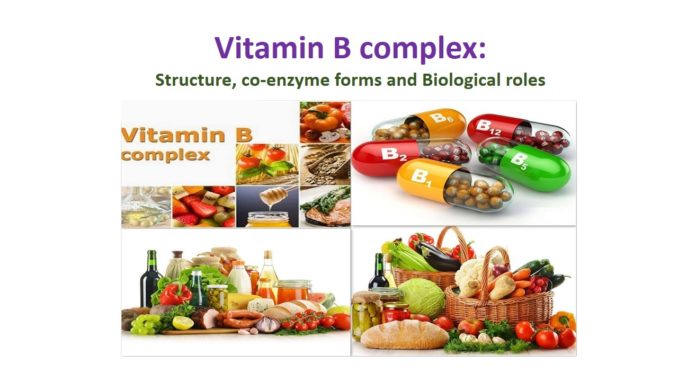
- Vitamins are organic compound which in small amounts is required to perform specific biological function for normal maintenance and optimum growth of body.
- Vitamin B was originally referred as a vitamin whose deficiency caused Beriberi in man and polyneuritis in birds.
- At this time, Vitamin B complex consists of a group of at least 13 components known as B1, B2, B3…. etc, but to make it easier, chemical names are commonly known these days.
- Despite being physiologically and chemically dissimilar, they have following common features:
- All of them are water-soluble. Exception: lipoic acid
- Majority of them are components of coenzymes that accounts for various roles in metabolism.
- Liver and yeast are the common source for most of them.
- The intestinal bacteria synthesize most of them.
Coenzyme form of Vitamin B
| Vitamin B complex | Co-enzyme form |
| Vitamin B1 (Thiamine) | Thiamine pyrophosphate (TPP) |
| Vitamin B2 | Flavin mononucleotide (FMN) Flavin adenine dinucleotide (FAD) |
| Vitamin B3 | Co-enzyme A (CoA) |
| Vitamin B5 | Nicotinamide adenine dinucleotide (NAD) Nicotinamide adenine dinucleotide phosphate (NADP) |
| Vitamin B6 | Pyridoxal phosphate (PALP), Pyridoxamine phosphate (PAMP) |
| Vitamin B7 | Biocytin |
| Vitamin B9 | Tetrahydrofolic acid (THFA) |
| Vitamin B12 | Deoxyadenosyl cobalamin |
Structures of vitamin B complex forms:
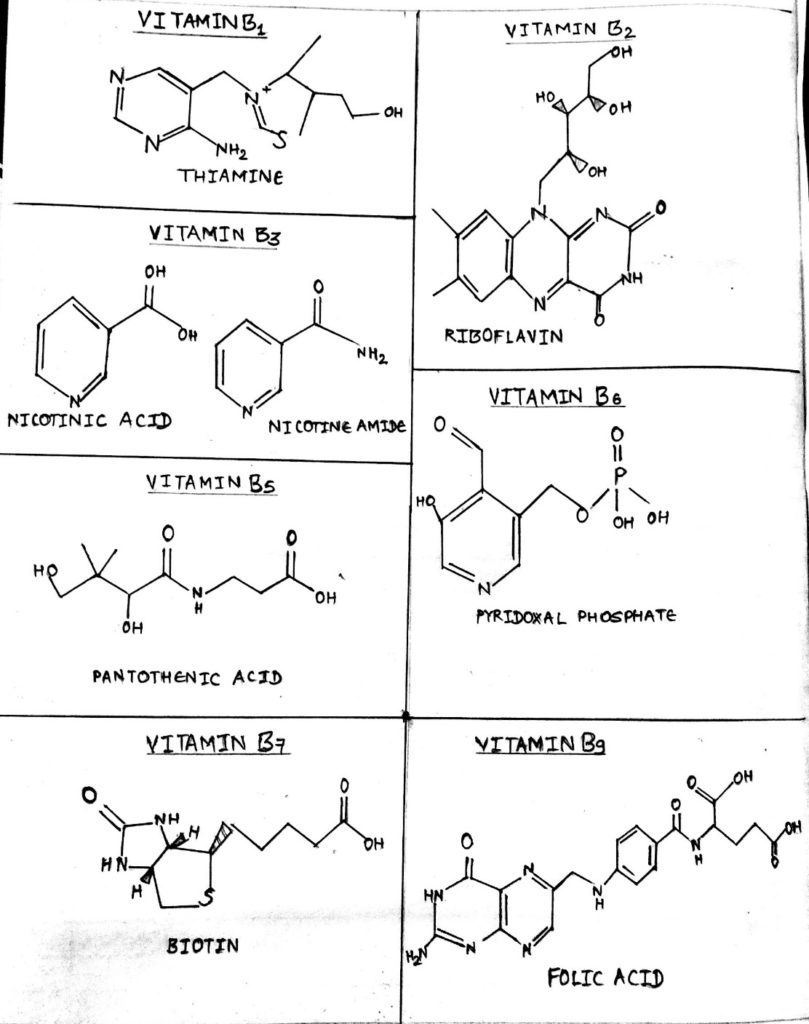
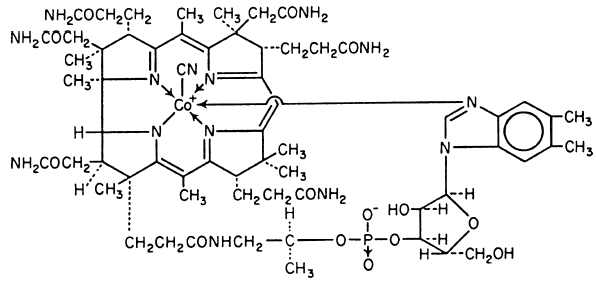
Biological functions of Vitamin B complex:
I. Biological functions of Vitamin B 1 (Thiamine pyrophosphate)
- i). The oxidative decarboxylation of pyruvate to acetyl CoA is catalyzed by pyruvate dehydrogenase complex.
- It comprises of co-enzymes such as Thiamine pyrophosphate (TPP), Lipoic acid, Niacin, Riboflavin.
- ii). 𝛼-keto acid dehydrogenase complex catalyzes oxidative decarboxylation of branched chain amino acid (valine, iso-leucine, leucine) into their respective keto-acids. This enzyme also comprises TPP as co-enzymes.
- 𝛼-ketoglutarate—-à succinyl CoA
- iii). TPP plays central role in synthesis of nucleic acid and lipids as they catalyze transketolase reaction of pentose phosphate pathway.

- iv). TPP is required for synthesis of acetyl-choline and help in nerve impulse conduction.
II. Biological functions of Vitamin B2 (Riboflavin):
- Riboflavin play role in carbohydrates, lipid, purine and amino-acid metabolism.
i. Role of riboflavin in Carbohydrate metabolism:
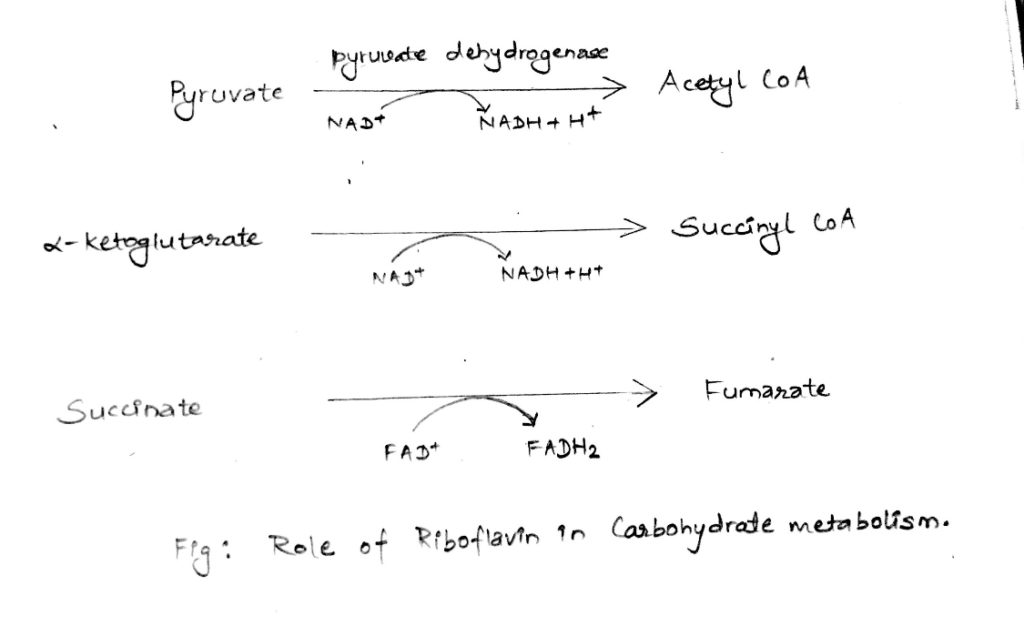
ii. Role of riboflavin in lipid metabolism:
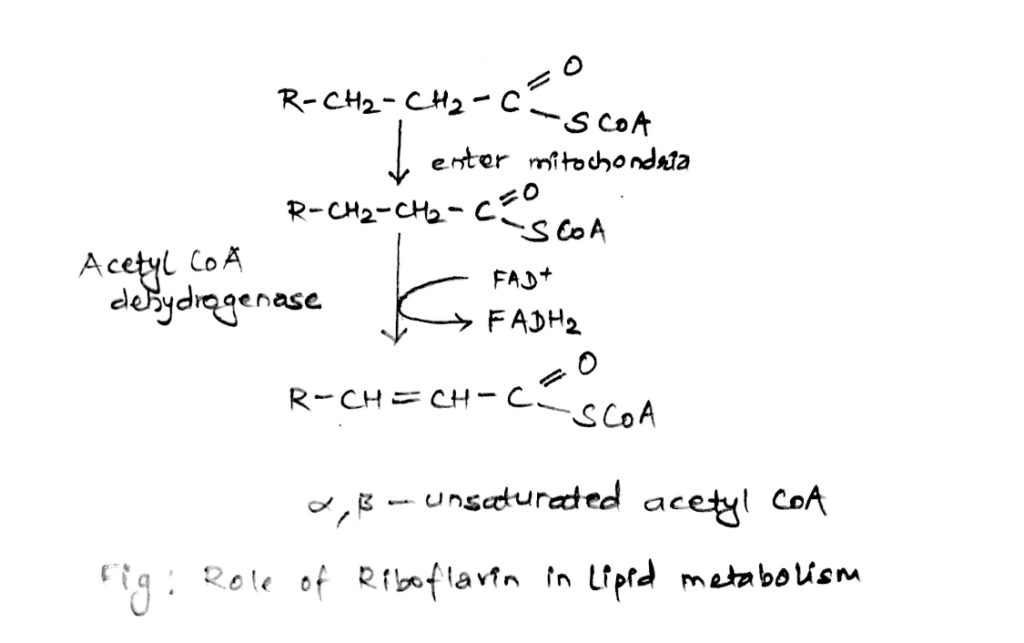
iii. Role of Riboflavin in amino-acid metabolism:
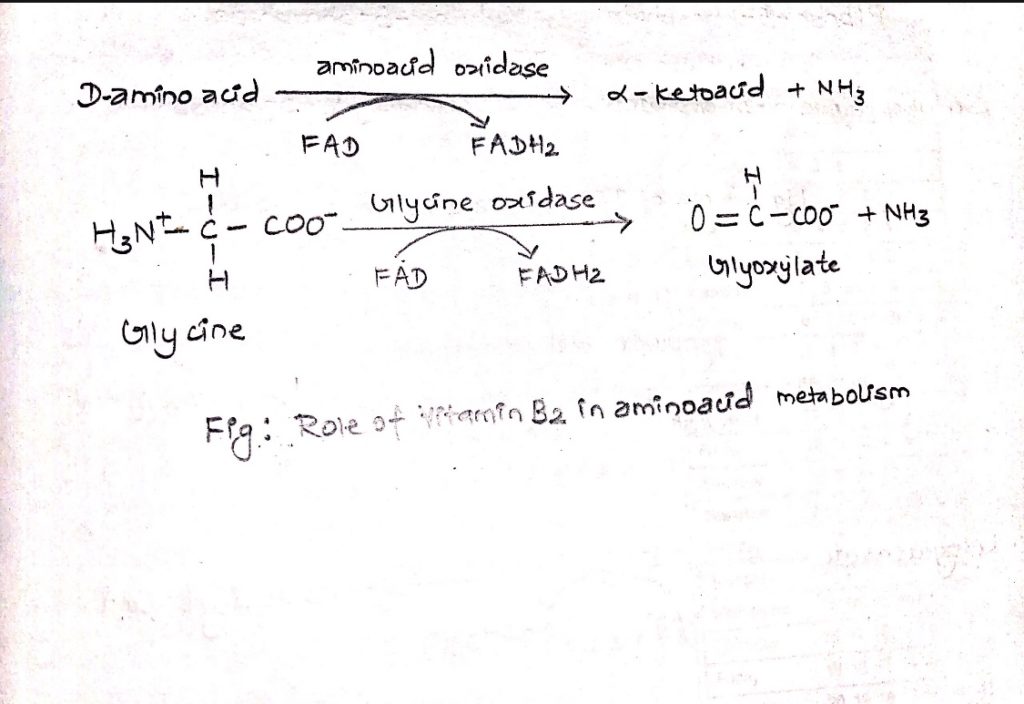
iv. Role of Riboflavin in purine metabolism:
- Xanthine oxidase is FAD dependent.
- FADH2 is required for reduction of ferrodoxin for the conversion of ribonucleotide to deoxyribonucleotide.
- FAD is also required to convert retinol to retinoic acid.
- L-amino acid is FMN dependent and is required for conversion of L-amino acid to L-ketoacid+ NH3.
- Synthesis of vitamin B6 is also FAD dependent.
III. Biological functions of Niacin (Vitamin B3):
- Niacin is required for activity of co-enzymes NAD+ / NADH+ or NADPH.
- Enzymes involved in metabolism of carbohydrates, protein, fats and purine are NAD+ /NADH+ or NADPH dependent.
i. Role of Niacin in carbohydrate metabolism:
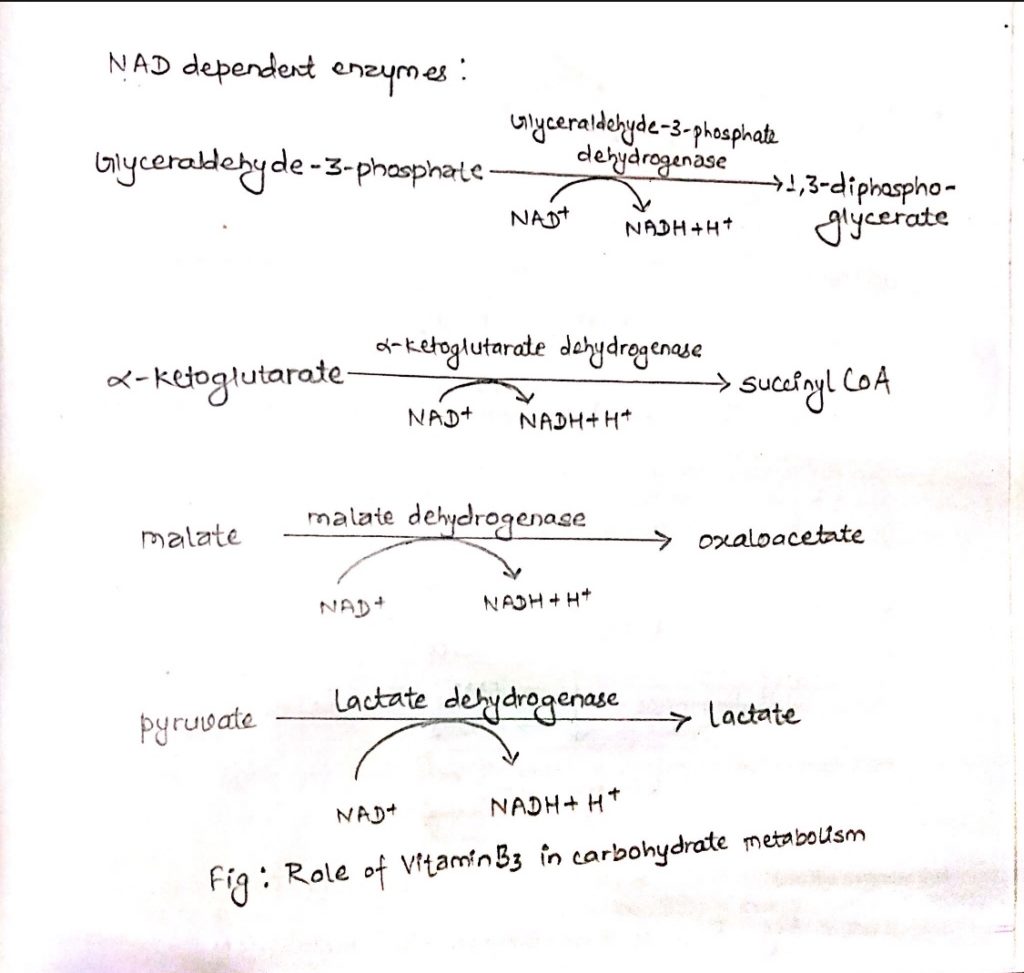
ii. Role in lipid metabolism:
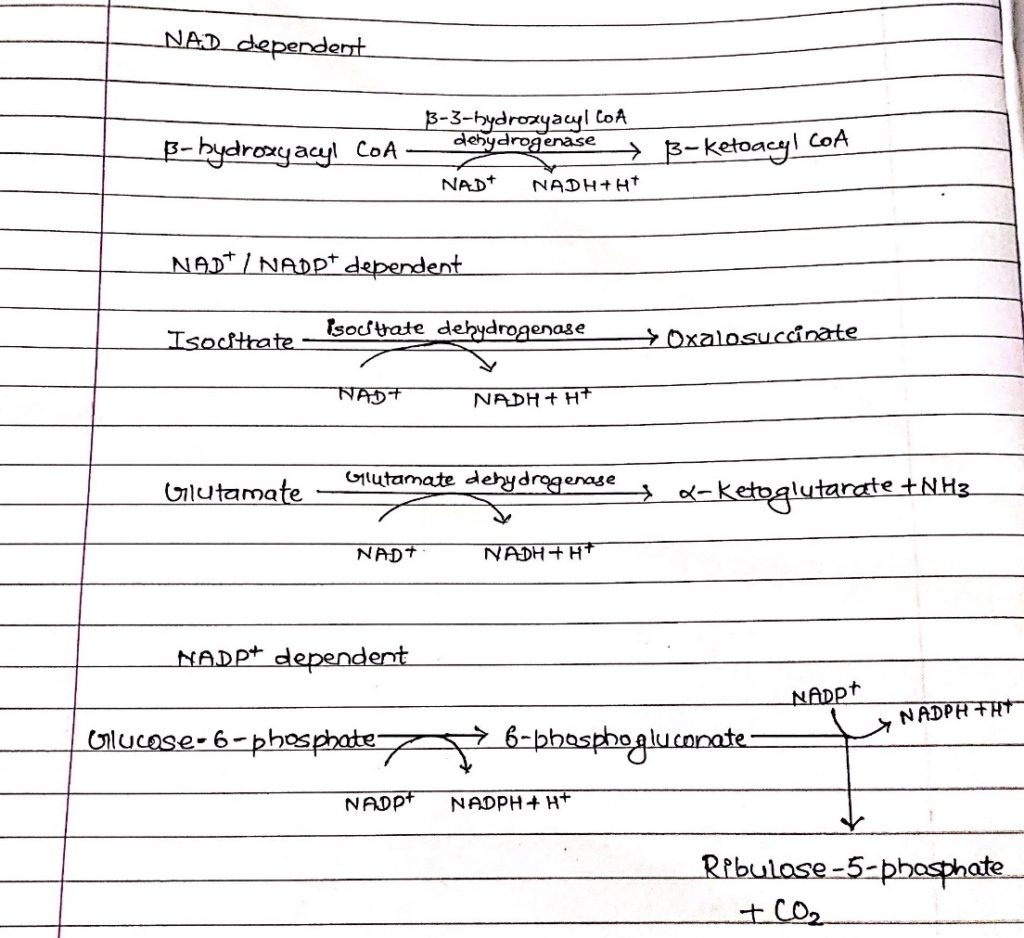
NAD dependent:
- hydroxy acyl CoA dehydrogenase is NAD dependent enzyme which is required for oxidation of fatty acids.
NADP+ dependent:
- Glucose-6-phosphate dehydrogenase is NADP+ dependent and this enzyme catalyze conversion of glucose-6-phosphate to 6 phosphogluconate and then to Ribulose-5-phosphate.
- Malic enzyme is NADP+dependent
NADPH dependent:
- DHFR is NADPH dependent.
- HMG CoA reductase ( -hydroxy- -methyl-glutaryl CoA reductase) is NADPH dependent.
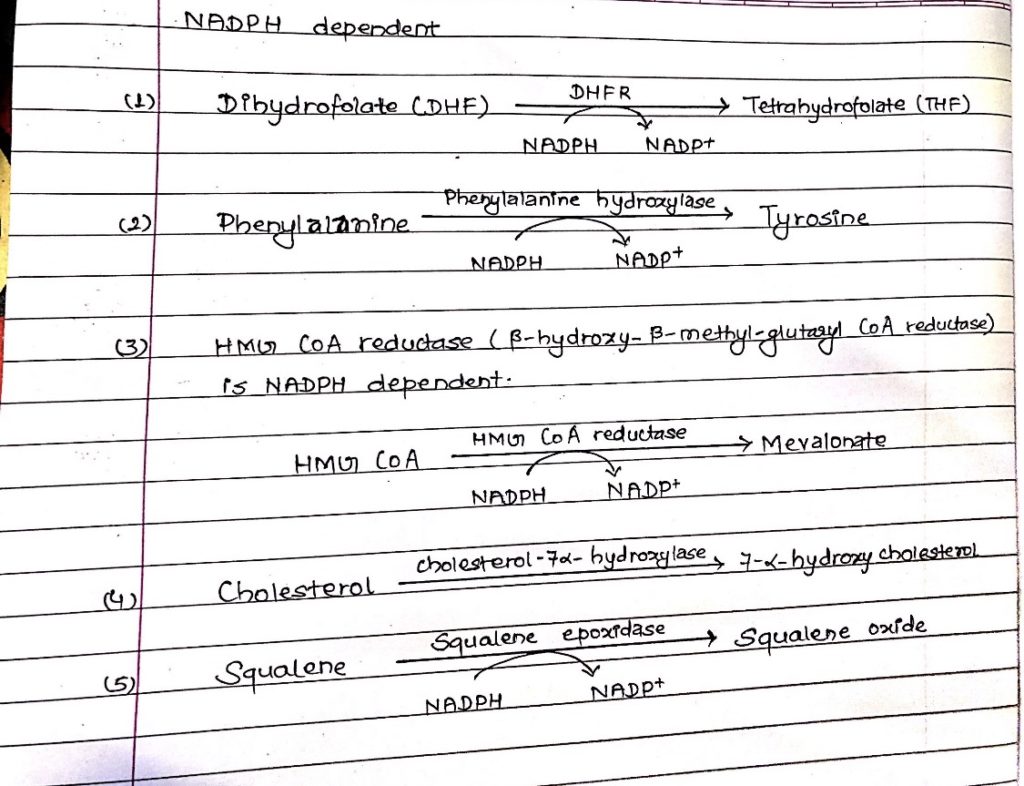
- Conversion of ribonucleotide to deoxyribonucleotide is catalysed by the enzyme ribonucleotide reductase.
- Ferrodoxin (Thioredoxin and glutathioreductase) reductase are required in reduced form for the activity of this enzyme and NADPH is required for this purpose.
- Conversion of IMP to GMP required IMP dehydrogenase and is NADPH dependent.
Deficiency of niacin:
- Pellagra:
- It is characterized by 3D’s (Diarrhea, Dementia and dermatitis).
- This occurs in those population having simple diet as corn.
IV. Biological functions of Vitamin B 5 Pantothenic acid:
- Co-enzyme play central role in metabolism. There are number of functions of CoA.
- They are carrier of activated acetyl CoA group. Some of functions are:
- Pyruvate ________________________> Acetyl CoA
- α-ketoglutarate ____________________> Succinyl CoA
- Acetyl CoA + Oxaloacetate ________________> Citrate
- Acetyl CoA + Choline ________________> Acetylcholine
- Succinyl CoA + Glycine ________________> Heme
- Succinyl CoA + acetoacetate _____________> succinate + acetoacetyl CoA
- Pantothenic acid is a component of fattyacid synthase complex and therefore play role during fatty acid synthesis.
- Acetyl CoA is used for synthesis of ketone bodies (acetone, -hydroxy butyrate and acetoacetate)
V. Biological functions of Vitamin B6 (Pyridoxal phosphate):
- Pyridoxal phosphate catalyses transamination, decarboxylation, condensation, deamination and trans-sulphuration.
i. Transamination
- Transamination reaction is useful in nitrogen metabolism especially in preventing accumulation of NH3 which is degraded by urea cycle.
- Transamination also generate keto-acid which can be used in metabolism whenever energy is required.
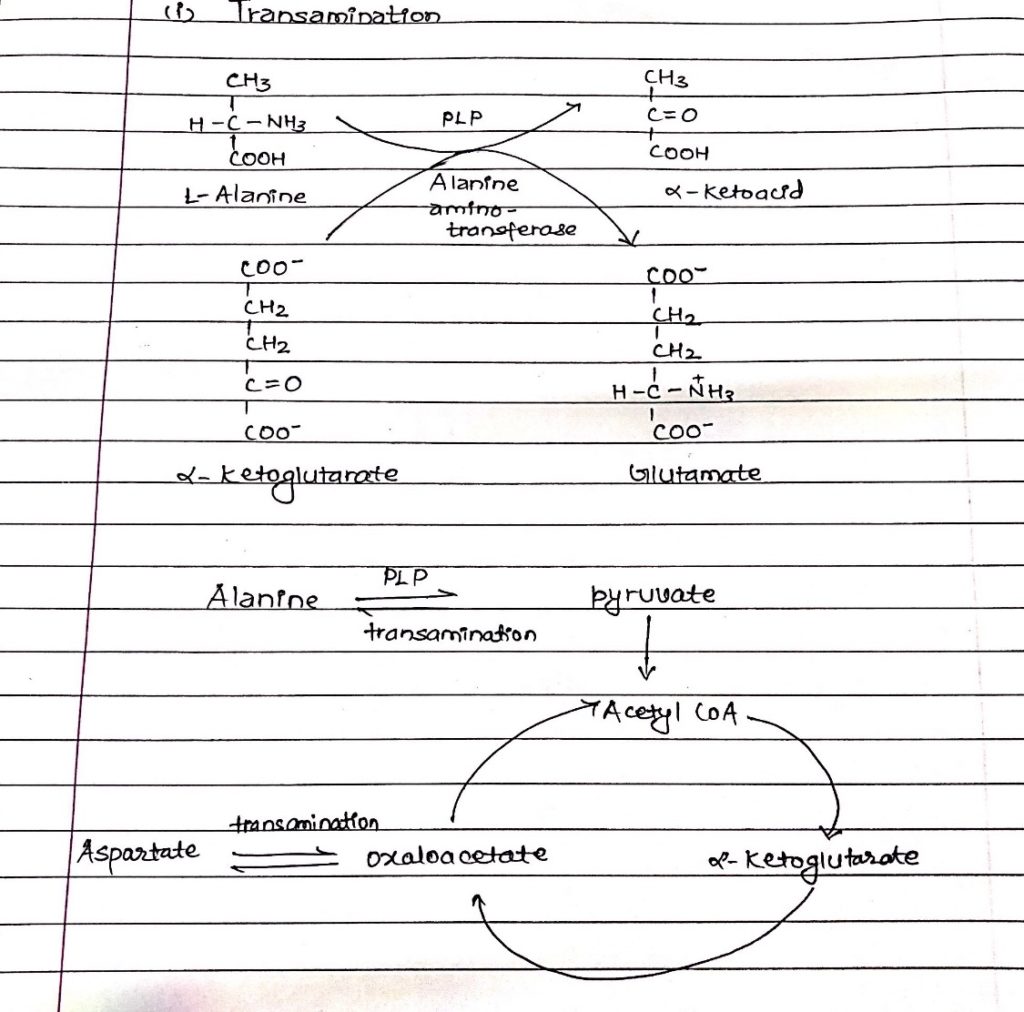
ii. Deamination:
- Pyridoxal phosphate acts as a co-enzyme in the synthesis of different biogenic amines that regulate sleep behaviour, blood pressure, nerve impulse transmission, inhibition of neurotransmitter, packaging of DNA.
- Decarboxylation of tryptophan
- Synthesis of catecholamine
- Synthesis of histamine
- Decarboxylation of glutamate yield GABA ( -amino butyric acid) which is inhibitory neurotransmitter).
- Ornithine is used for synthesis of spermidine and spermine. These amines are used in DNA packaging.
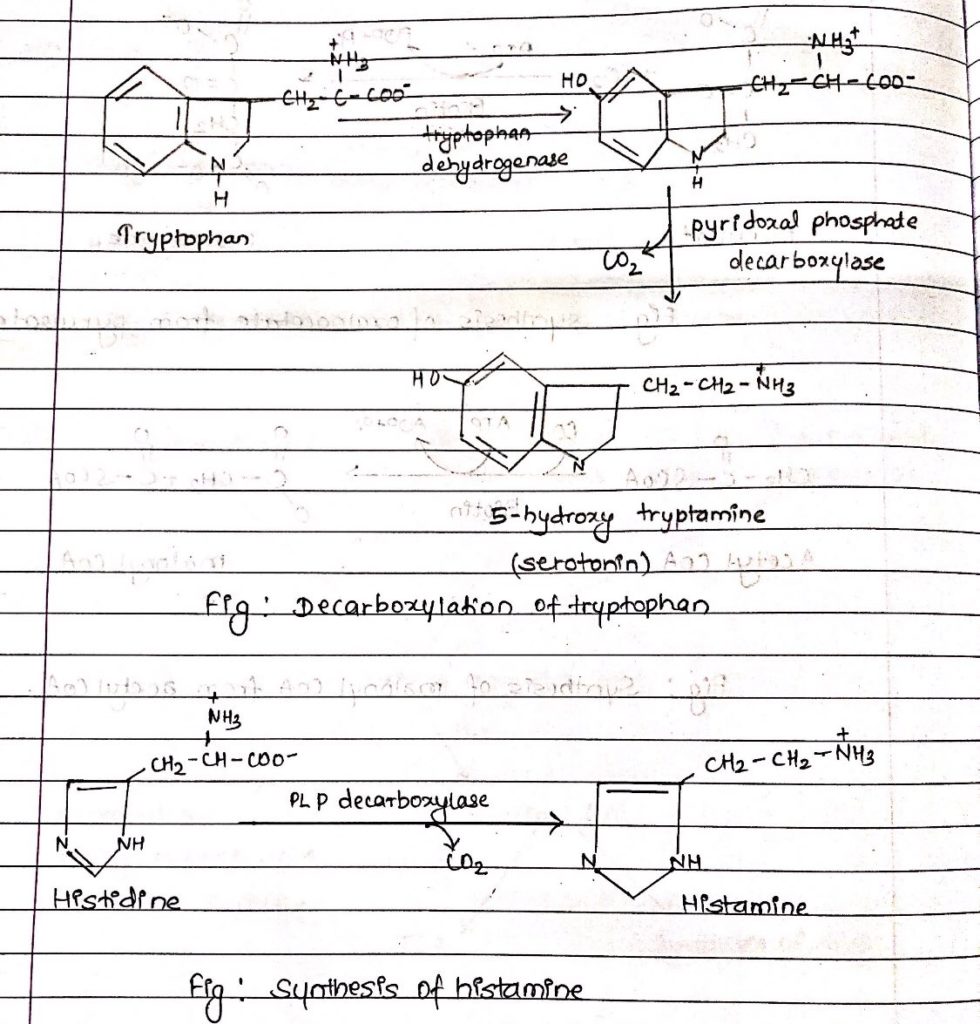
iii. Condensation
- Pyridoxal phosphate catalyse synthesis of heme by condensation reaction.
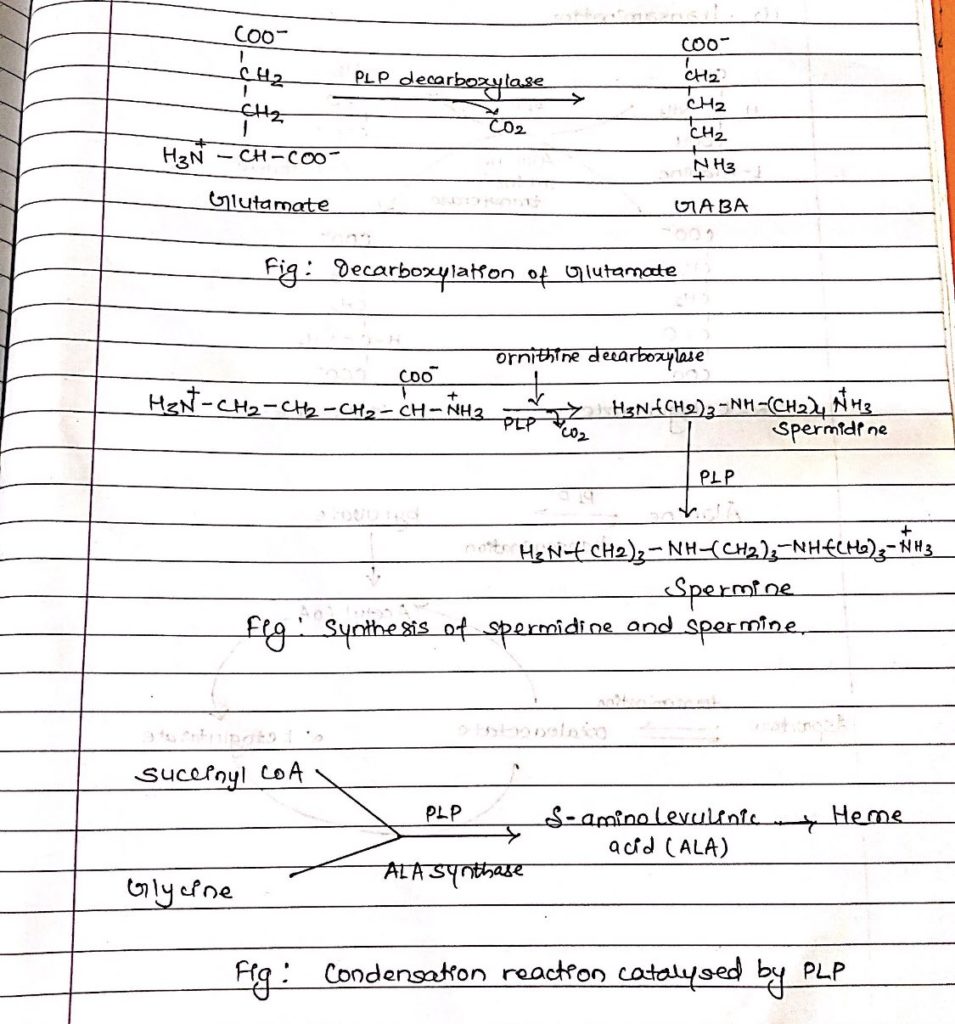
iv. Trans-sulfuration:
- Trans-sulfuration between homocysteine and serine give cystathionine.
- This reaction is catalysed by PLP dependent enzyme.
v. Deamination:
- Pyridoxal phosphate is involved in deamination of hydroxy group containing aminoacids (Serine and threonine).
- During glycogenolysis, the activity of enzyme glycogen phosphorylase is PLP dependent.
- PLP catalyse folate metabolism.
- PLP is required for synthesis of NAD+/NADP+ from tryptophan.
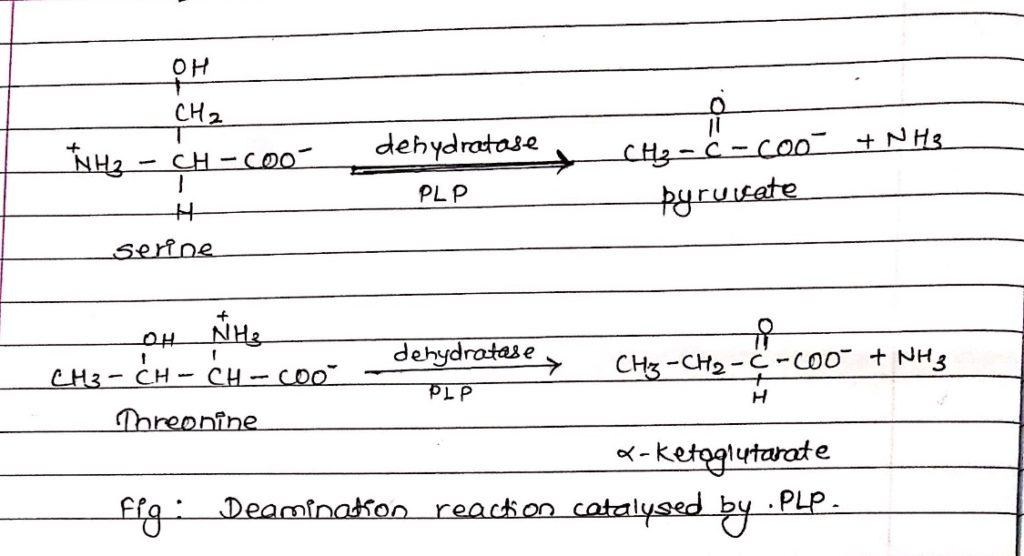
Deficiency of vitamin B6:
- The cases of diseases associated to deficiency of Vitamin B6 is unknown.
- However, neurological symptoms are seen.
VI. Biological functions of Vitamin B7 (Biotin):
- Almost all carboxylation reaction like incorporation of CO2 during purine synthesis and synthesis of carbamoyl phosphate during urea cycle are independent of biotin.
- Examples of carboxylation reaction catalysed by biotin are:
- Gluconeogenesis and citric acid cycle:
- The role of biotin is in the synthesis of oxaloacetate from pyruvate during gluconeogenesis and in citric acid cycle, to regenerate oxaloacetate which can be re-used during sufficient sound of cycle.
- In lipid metabolism:
- Biotin is required in the synthesis of malonyl CoA from acetyl CoA which is necessary during initial stages of fatty acid biosynthesis.
- Metabolism of odd chain fatty acid and certain aminoacids like valine, isoleucine and threonine.
- Proponyl CoA is produced during metabolism of odd chain fatty acid and certain amino acids like valine, isoleucine and threonine and is converted into succinyl CoA and the process is dependent on biotin.
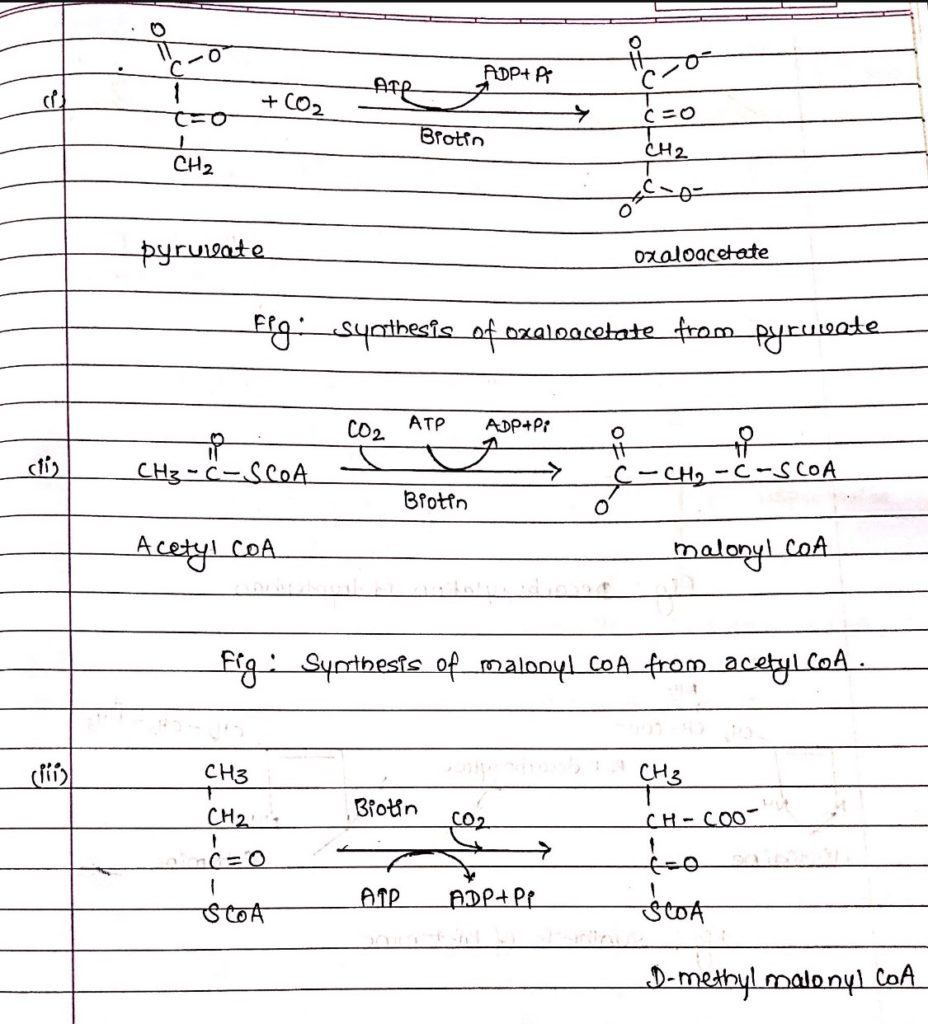
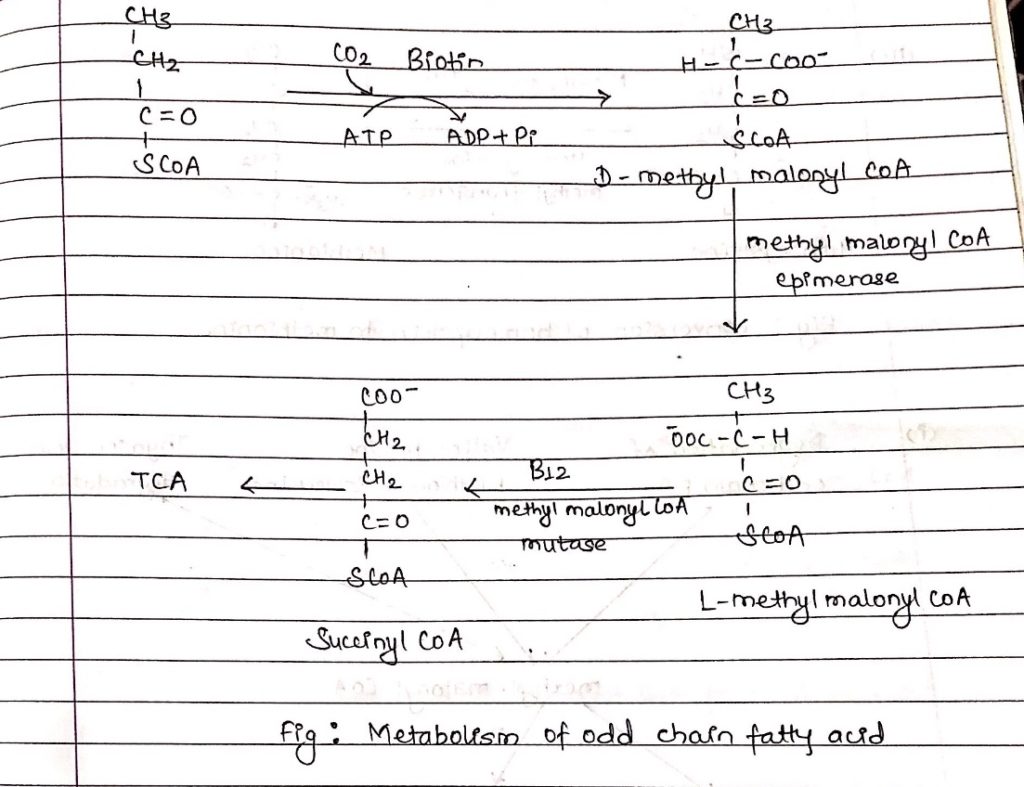
Deficiency:
- Deficiency is rare but can occur upon the consumption of drug like sulphonamides that can destroy the gastro-intestinal flora and upon the consumption more than 20 raw eggs per day.
VII. Biological Functions of Vitamin B9 (Folic acid):
- Active form of folic acid is THF.
- THF is involved in one carbon metabolism where it transfers methyl, methylene, methenyl, and formyl groups.
- N10 formyl THF is used for activation of amino acid with their respective tRNA.
- THF play important role in purine biosynthesis.
- THF catalysis pyrimidine synthesis during conversion of dUMP to dTMP.
- THF is required for synthesis of glycine, serine and choline.
Biological functions of Vitamin B12 (Cyanocobalamine):
- B12 is required for the maintenance of cellular integrity by keeping the normal structure of cell membrane intact.
- It is also important in folate metabolism where it releases THF from trapped N5-methyl THF form.
- These are the only two important function of Vit B12 in mammals.
i. Synthesis of succinyl CoA from propionyl CoA
- Propionyl CoA ______________> Succinyl CoA
- Degradation of odd chain FA, valine, proline, methionine, isoleucine, thymine and uracil give methyl malonyl CoA.
- Methyl malonyl CoA in presence of B 12 form succinyl CoA.
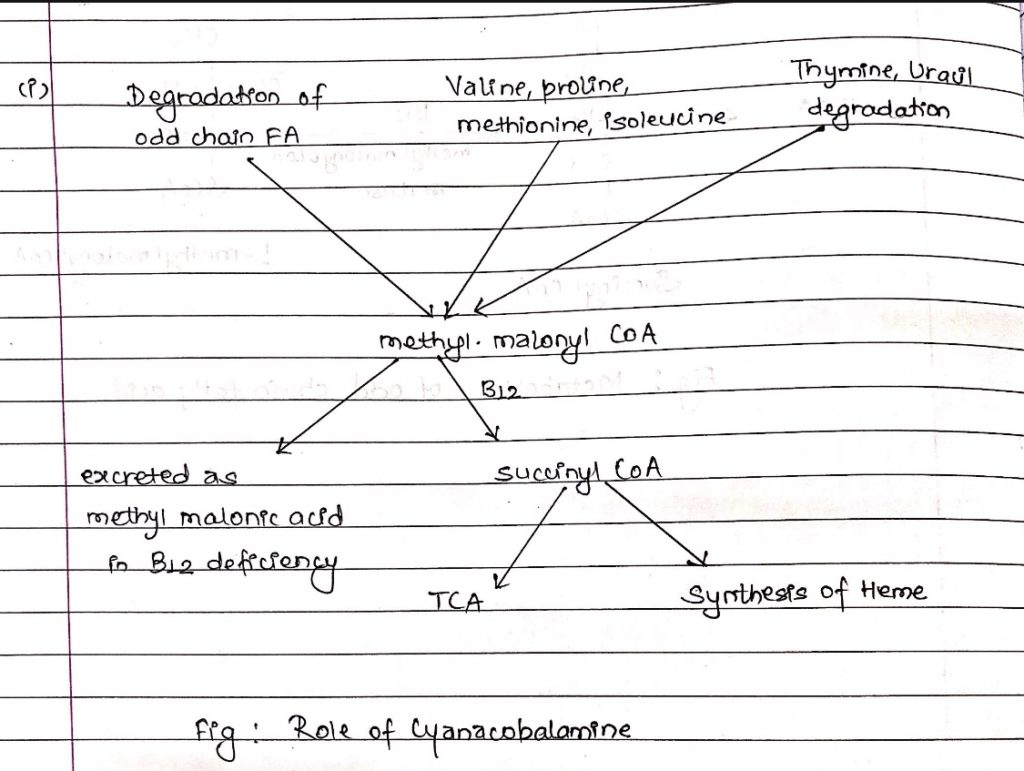
ii. Maintenance of cell membrane integrity:
- Malonyl CoA is required for biosynthesis of FA, methyl malonyl CoA is its competitive inhibitor.
- In the absence of Vit B12, methyl malonyl CoA accumulates and FA synthesis is inhibited.
- This results in abnormal cell membrane.
- Conversion of homocysteine to methionine (Release of THF from N5-methyl THF, in a reaction involving the conversion of homocysteine to methionine.
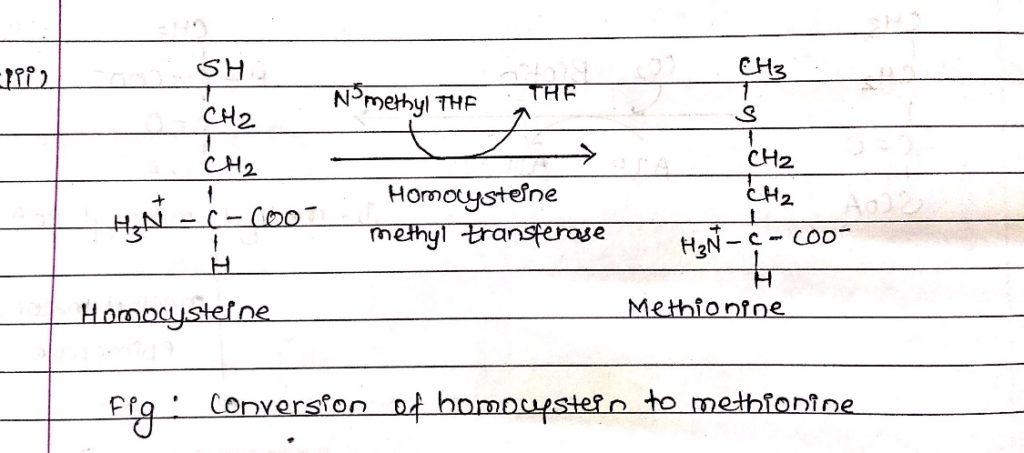
Dietary source:
- B12 is never found in foods of plant origin as plant cannot synthesized Vit B12.
- It is synthesized only by intestinal bacteria.
- B12 is only found in foods from animal sources such as liver, kidney, milk, curd, pork, chicken.
Deficiency of vitamin B12:
- Deficiency result in pernicious anemia which is characterized by low no. of erythrocytes, low Hb level and neurological manifestation.
- In B12 deficiency cell membranes are not properly formed and therefore the integrity of erythrocytes is abnormal.
- This is because of the impairment of fatty acids.
